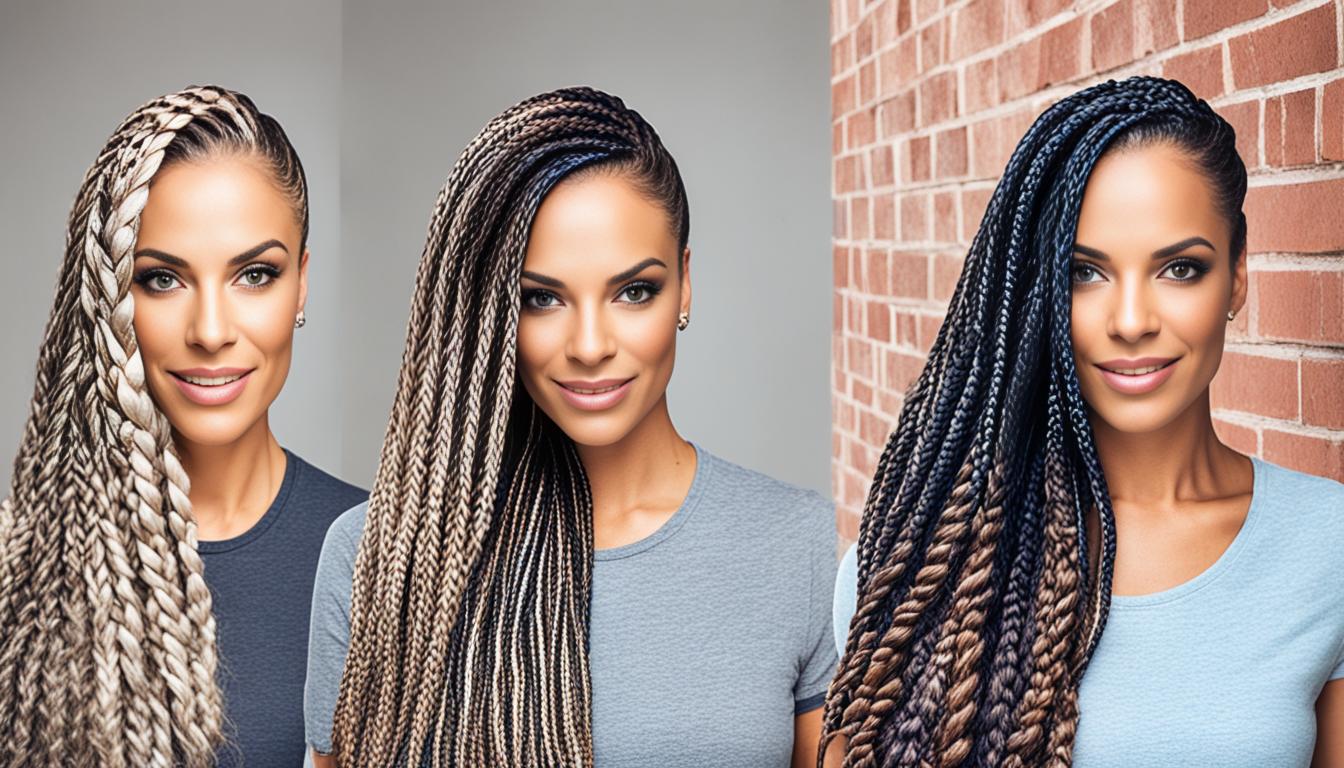
Braids are a popular and stylish hairstyle choice, but many people wonder if they can cause damage to their hair. Are braids really as harmless as they seem, or could they be silently damaging your precious strands? Let’s dive into the truth behind braids and whether they can be detrimental to your hair health.
When it comes to braids, it’s important to understand that the style itself doesn’t inherently damage the hair. However, certain styling techniques and tight braids can lead to breakage, follicle damage, and even hair loss. It’s crucial to take proper care of your hair while wearing braids to minimize any potential damage and promote overall hair health.
In this article, we will explore the impact of ponytails and buns, the effects of tight braids, the dangers of styling wet hair, sleeping with hair in a bun, straightening, and the impact of hair extensions on hair health. By uncovering the potential risks associated with these hairstyles and techniques, you will gain a better understanding of how to maintain healthy hair while still enjoying the beauty and versatility of braids.
Key Takeaways:
- Braids themselves don’t damage the hair, but certain styling techniques and tight braids can lead to breakage and hair loss.
- Wearing ponytails and buns every day can cause stress on the hair, leading to breakage and damage.
- Tight braids can result in hair breakage, splitting, and traction alopecia.
- Styling wet hair, especially in updos or tight braids, can cause damage and breakage.
- Sleeping with hair in a bun can lead to tangles, friction, and hairline damage.
The Impact of Ponytails and Buns on Hair Health
Wearing ponytails and buns can be a convenient and simple way to style your hair. However, constantly wearing your hair in the same style can lead to damage and breakage, particularly at the base of the ponytail or bun. This repeated stress on the same spot can weaken the hair strands and cause snapping.
To minimize the potential damage caused by ponytails and buns, it is advisable to avoid tight hairstyles that pull on the hair. Instead, opt for looser styles that provide some relief to the hair follicles. Switching up your hairstyles regularly can also help distribute the tension and reduce the risk of breakage.
Additionally, the type of hair tie you use can make a difference in minimizing damage. Traditional rubber bands can be harsh on the hair, causing friction and breakage. Instead, try using fabric-coated hair ties or scrunchies, which are gentler on the hair and less likely to cause damage.
The Pitfalls of Tight Ponytails and Buns
When ponytails and buns are worn tightly, they can put excessive tension on the hair and scalp. This tension can lead to a condition called traction alopecia, where the hair follicles become weakened and hair loss occurs. It is essential to strike a balance between style and hair health by avoiding overly tight hairstyles and providing your hair with regular breaks from ponytails and buns.
“Constantly wearing tight ponytails and buns puts stress on the hair, leading to breakage and potential hair loss.”
Choosing the Right Hair Accessories
The type of hair accessories you use can significantly impact the health of your hair. Avoid using hair elastics with metal parts, as they can snag and damage the hair. Instead, opt for fabric-coated hair ties or scrunchies that are specifically designed to be gentle on your hair. These alternatives minimize friction and reduce the likelihood of breakage.
By making simple adjustments to your hairstyle choices and opting for gentler hair accessories, you can enjoy the convenience and style of ponytails and buns while minimizing the potential damage to your hair.
The Effects of Tight Braids on Hair Health
Braids are a popular and versatile hairstyle, but when done too tightly, they can cause damage to your precious locks. Tight braids can lead to hair breakage, splitting, and even follicle damage.
The constant tension that tight braids exert on the hair follicles weakens them over time, making them more prone to breakage. This increased tension can also result in a condition called traction alopecia, which is characterized by hair loss due to the constant pulling and strain on the hair strands.
To minimize the damage caused by tight braids, it’s important to take a few preventive measures. First and foremost, avoid braiding the hair too tightly at the scalp. Opt for a looser braiding style that allows for some movement and doesn’t put excessive strain on your hair follicles.
Additionally, it’s crucial to give your hair regular breaks from braids. Constantly wearing tight braids without allowing your hair time to rest can exacerbate the damage and increase the risk of hair breakage. Give your hair a break between braid styles to promote healthier hair growth and reduce the chances of further damage.
To further protect your hair, moisturize your scalp with essential oils or hair serums. This helps to nourish the scalp and hair follicles, promoting better hair health and reducing the risk of damage due to tight braiding.
Remember, it’s essential to prioritize the health and well-being of your hair when choosing braided hairstyles. Opt for looser braids, take regular breaks, and nourish your scalp to minimize the damage caused by tight braids.
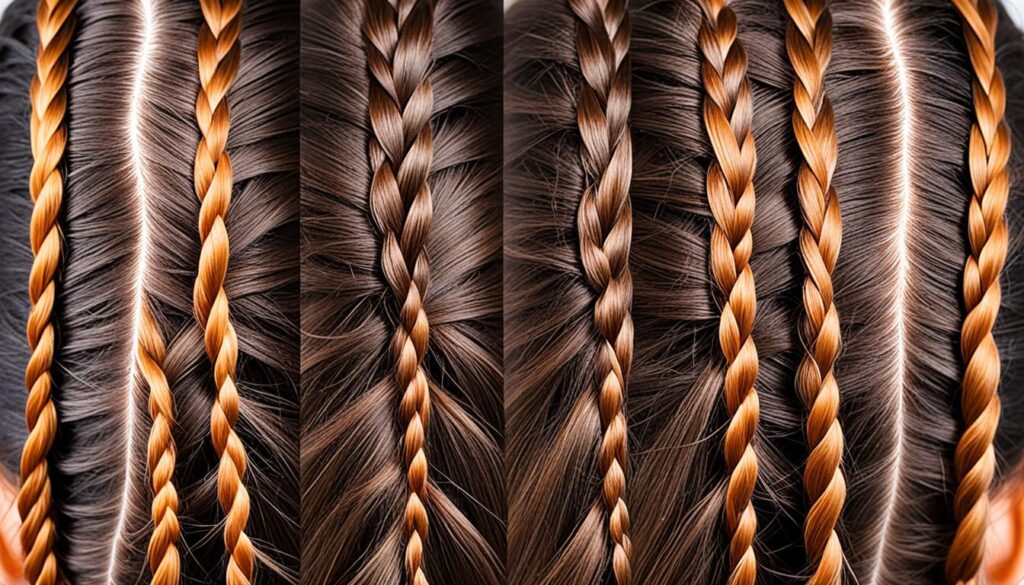
“Tight braids can cause hair breakage, splitting, and follicle damage, leading to traction alopecia.” – Hair Specialist
The Dangers of Styling Wet Hair
Styling wet hair can be a convenient option when you’re short on time, but it’s important to be aware of the potential damage it can cause. Wet hair is more fragile and prone to breakage, especially when subjected to twisting, pulling, or stretching. This is particularly true for delicate ends that are more vulnerable to damage. Additionally, as wet hair dries, the tension on it increases, which can lead to hair loss over time.
To minimize the risk of wet hair damage, it’s best to avoid tying up or braiding wet hair. Instead, opt for alternative styling methods that are gentler on your hair. Allow your hair to air dry or use a diffuser when blow-drying to reduce the amount of heat and tension applied to wet strands. Once your hair is completely dry, you can then style it as desired.
“It’s crucial to handle wet hair with care to prevent breakage and long-term damage. Using minimal heat and avoiding tight styles can help protect your precious strands.”
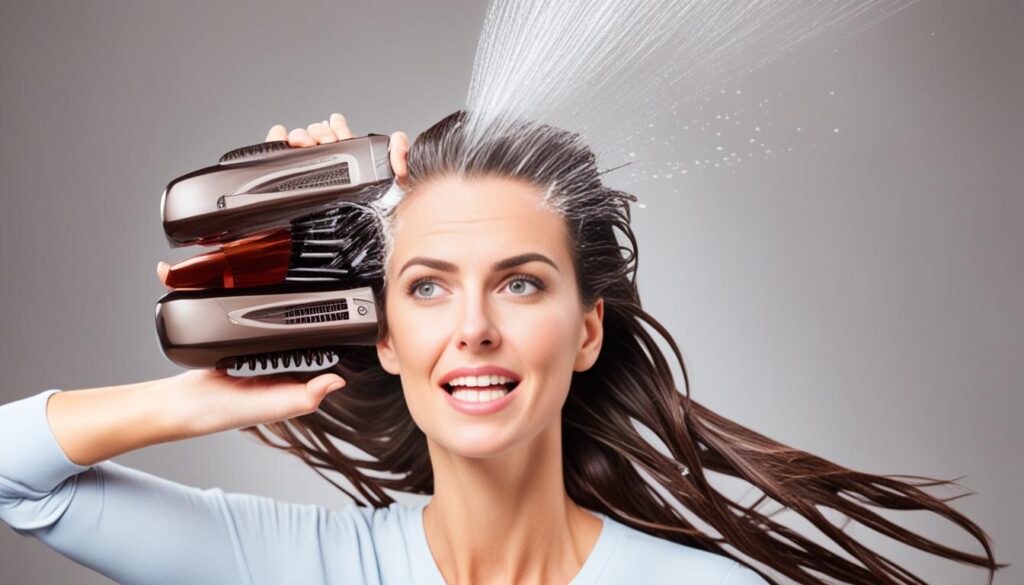
Tips for styling wet hair:
- Towel-dry gently: Avoid vigorously rubbing your hair with a towel to prevent excessive friction and breakage.
- Use a wide-tooth comb: Detangle your hair using a wide-tooth comb to minimize breakage.
- Avoid heat styling: Heat styling tools can further weaken wet hair, so it’s best to wait until your hair is completely dry before using them.
- Apply a heat protectant: If you must use heat styling tools on slightly damp hair, always use a heat protectant to minimize damage.
- Moisturize regularly: Keep your hair and scalp hydrated by using moisturizing products and oils.
“Styling wet hair can put unnecessary strain on the hair fibers, leading to breakage and loss. Take your time, be gentle, and prioritize the health of your hair.”
The Impact of Sleeping with Hair in a Bun
Sleeping with your hair in a bun can have unintended consequences on its health. While it may seem like a convenient option, it can lead to tangles, friction, and even hairline damage.
When you toss and turn during sleep, the bun can create friction against the pillow and pull on the delicate hairline, causing breakage and damage. Over time, this can lead to weakened and thinning hair along the hairline, hindering healthy hair growth.
To minimize potential damage and preserve the health of your hair, consider the following tips:
- Use satin or silk pillowcases or scarves: These materials help reduce friction between the hair and the pillow, minimizing hair breakage and tangles.
- Keep the bun loose: Avoid tight buns that pull on the hairline. Opt for a loose and comfortable bun that doesn’t place unnecessary stress on the hair.
- Moisturize the hair: Before putting your hair in a bun, apply a leave-in conditioner or oil to moisturize and protect your strands while you sleep.
- Consider alternative hairstyles: If you’re concerned about hairline damage, try other sleep-friendly hairstyles like loose braids or a loose ponytail to minimize tension on the hairline.
Remember, it’s important to give your hair time to breathe and recover from the stress of styling during the day. Avoid frequent tight buns and allow your hair to rest and regain its natural strength overnight.
| Benefits of Sleeping with Hair in a Bun | Potential Damages |
|---|---|
| Convenience: Sleeping with a bun keeps the hair off your face and neck, reducing discomfort. | Tangles: The bun can create tangles and knots in the hair, leading to breakage when combing or styling. |
| Preservation of hairstyle: Sleeping with a bun helps preserve curls or waves, reducing the need for restyling in the morning. | Hairline Damage: The bun can pull on the delicate hairline, leading to hair breakage and thinning along the edges. |
| Reduced friction: Using satin or silk pillowcases or scarves can minimize friction and prevent hair breakage caused by contact with rough cotton or polyester fabrics. | Friction: Tossing and turning on a rough pillowcase can create friction against the bun, causing hair breakage and damage. |
By adopting these precautions, you can sleep comfortably while minimizing unnecessary damage and promoting the health of your hair. Remember that healthy hair starts with proper care and attention, even while you sleep.
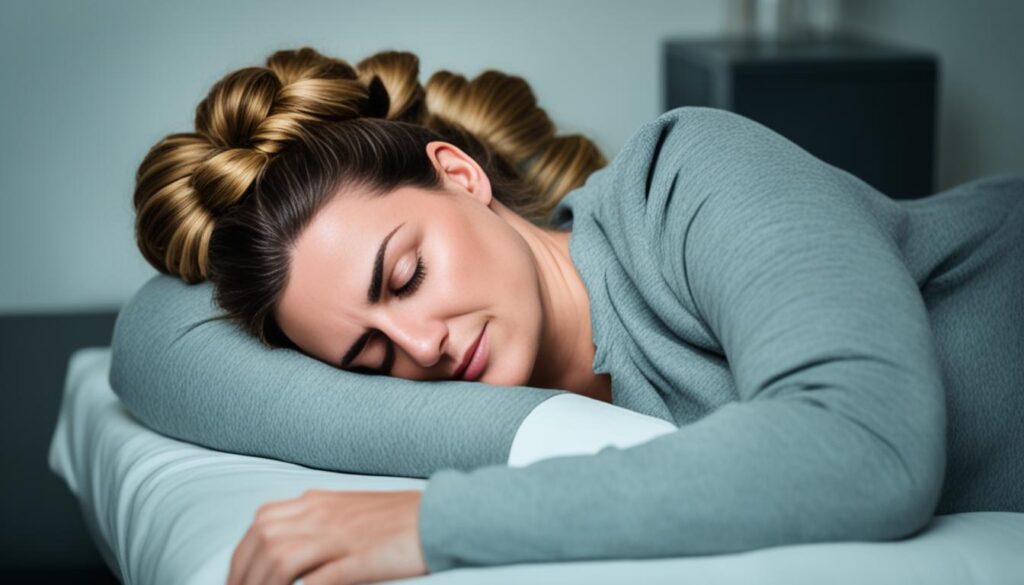
The Effects of Straightening on Hair Health
When it comes to hair straightening, it’s important to be aware of the potential damage it can cause to your hair.
Straightening the hair using thermal heat can weaken the hair bonds and result in split ends and damage. Excessive use of heat can physically alter the inner structure of the hair, making it more prone to splitting.
To minimize the damage caused by hair straightening, there are a few key steps you can take:
- Use amino acid-based products: Look for shampoos, conditioners, and styling products that contain amino acids. These can help nourish and strengthen the hair, reducing the risk of damage from heat styling.
- Get keratin treatments: Keratin treatments can help restore and strengthen the hair by replenishing lost proteins. These treatments can improve the overall health of your hair, making it more resilient to thermal heat damage.
- Use steam-infused flat irons: Traditional flat irons can strip moisture from the hair, exacerbating the risk of split ends. Opt for steam-infused flat irons that help seal moisture into the hair, reducing damage and promoting healthier, smoother hair.
By following these steps, you can enjoy the benefits of straightened hair while minimizing the risk of thermal heat damage and split ends.
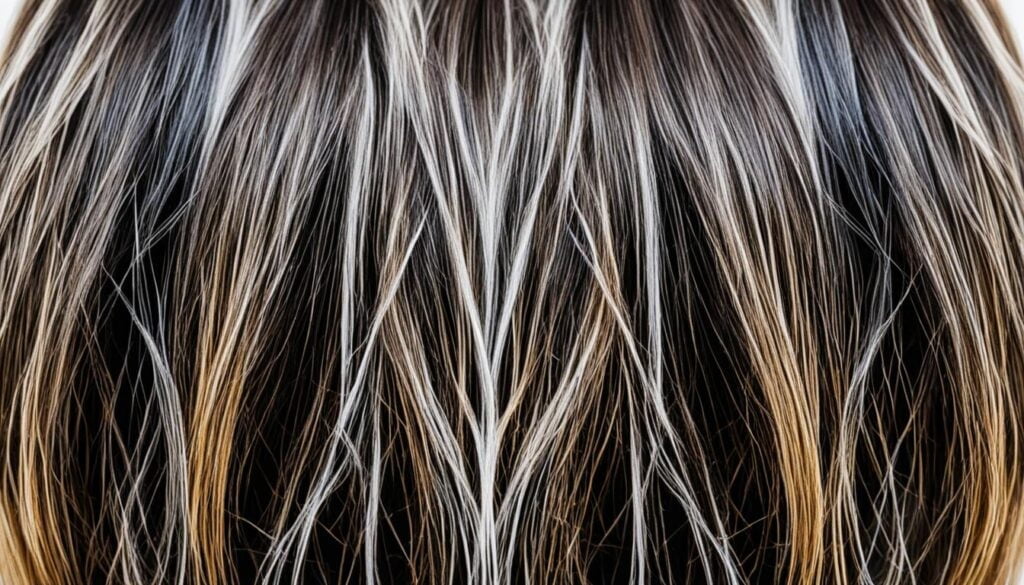
Expert Insight:
“Repeated use of high heat without proper protection can lead to irreversible damage to the hair. It’s crucial to prioritize hair health and take necessary precautions while straightening to avoid long-term consequences.” – Dr. Ava Thompson, Hair Specialist
The Impact of Hair Extensions on Hair Health
Wearing hair extensions can have both positive and negative effects on your hair health. While they can provide added length and volume, improper maintenance and attachment techniques can lead to damage. It’s important to understand the potential risks and take proper care of your hair extensions to minimize any potential damage and maintain the health of your natural hair.
One of the main concerns with wearing hair extensions is the weight they add to your natural hair. The added weight can put stress on your hair follicles and roots, leading to breakage and damage. It’s important to choose the right type of extensions that are suitable for your hair type and ensure that they are properly installed to distribute the weight evenly.
Additionally, improper maintenance of hair extensions can also cause damage. Neglecting to detangle and remove knots can result in hair breakage, especially at the areas where the extensions are attached. It’s crucial to regularly brush your hair extensions with a soft-bristle brush and gently remove any tangles to prevent unnecessary pulling and breakage.
To minimize damage and preserve hair health, it’s recommended to opt for semi-permanent or clip-in extensions. These types of extensions allow for easier maintenance and give your natural hair breaks from the added weight and stress. It’s also important to follow any maintenance guidelines provided by the hair extension supplier and schedule regular appointments for maintenance and removal to avoid any long-term damage.
Proper maintenance and regular check-ups with a professional can help minimize the risk of damage and ensure that your hair remains healthy and strong even with extensions.
Maintaining Healthy Hair with Hair Extensions: Tips and Tricks
Here are some tips to help you maintain the health of your natural hair while wearing extensions:
- Choose high-quality extensions that are made from real hair and match your natural hair’s texture and color.
- Consult with a professional stylist who specializes in hair extensions to ensure proper installation and maintenance.
- Follow the recommended maintenance routines provided by the hair extension supplier.
- Detangle your hair and extensions regularly using a soft-bristle brush.
- Avoid using excessive heat styling tools on your hair extensions to prevent damage.
- Moisturize your natural hair and scalp regularly to maintain their health.
- Give your natural hair breaks from extensions to minimize stress and damage.
By following these tips and maintaining a diligent hair care routine, you can enjoy the benefits of hair extensions while ensuring the health and integrity of your natural hair.
| Pros of Hair Extensions | Cons of Hair Extensions |
|---|---|
| – Provides added length and volume | – Weight of extensions can cause stress and damage to natural hair |
| – Allows for versatile styling options | – Improper maintenance can lead to tangling and breakage |
| – Can be used to experiment with different hair colors and styles | – Improper attachment techniques can result in discomfort and damage |
In conclusion, wearing hair extensions can be a great way to enhance your natural hair and achieve your desired look. However, it’s important to properly maintain and care for your extensions to minimize damage to your natural hair. By choosing high-quality extensions, following maintenance routines, and seeking professional advice, you can enjoy the benefits of extensions while preserving the health and strength of your hair.
Conclusion
While braids themselves are not damaging to the hair, it’s important to be mindful of certain styling techniques and avoid tight braids to prevent breakage and hair loss. To minimize hair damage and maintain healthy hair, it is recommended to follow these hair care tips when wearing braids.
Firstly, avoid tight hairstyles that can put excessive tension on the hair follicles. Opt for looser braids or styles that allow your hair to breathe. This helps to prevent the hair from becoming weak and prone to breakage.
Secondly, give your hair regular breaks between wearing braids. This allows for the hair to recover and rejuvenate. During this time, moisturize the scalp with essential oils to keep it nourished and hydrated.
Lastly, use proper hair care products that promote strength and minimize damage. Look for products that are specifically formulated for braided hair, such as leave-in conditioners and oils. These products help to nourish and protect the hair while minimizing frizz and breakage.
By implementing these hair care tips when styling your hair with braids, you can enjoy the beauty and versatility of braided hairstyles while maintaining healthy hair and minimizing damage. Remember, the key is to be gentle with your hair and give it the care it deserves.






